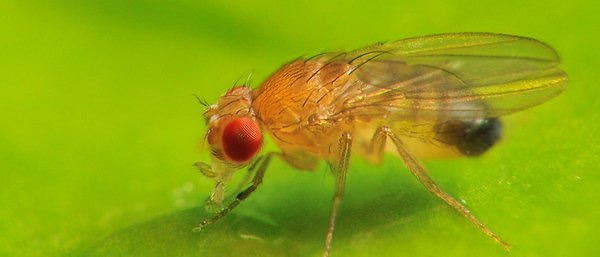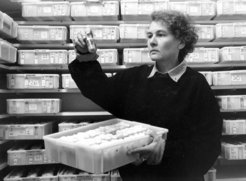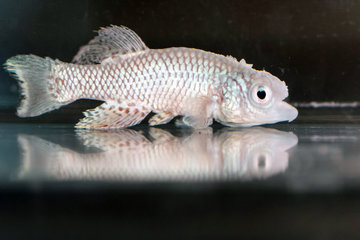
The fruit fly as a model organism
Thomas Hunt Morgan has now been studying flies in his "fly laboratory" at Columbia University for two years. Day after day, the trained geneticist feeds thousands of these insects, a mere three millimetres in length, with a mush consisting of over-ripe bananas, rehouses them and observes their appearance through a magnifying glass. His objective is to find a fly that looks different.
One morning in 1910, when he is checking one of his numerous glass tubes in which he keeps his flies, as he does every day, he can hardly believe his luck: among all the flies with red eyes, for the first time there is one with white eyes!
This misfit is now to reveal to him how a characteristic such as eye colour is passed on by parents to their progeny. To this end, Morgan pairs the white-eyed animal with a partner with red eyes, and from their offspring he breeds a line of flies which only have white eyes. After examining millions of flies from his cross-breeding experiments, he finally comes to the conclusion that the genetic material must be arranged on the chromosomes in linear order – an insight for which he will be awarded the Nobel Prize for medicine 20 years later.
Morgan's experiments are not only fundamental to our knowledge of heredity; they have also made an animal respectable for science, which previously only a few specialists had worked with: the fruit, vinegar or wine fly with the scientific name, Drosophila melanogaster.
Nobel Prizes for fly researchers

Anyone who has fresh fruit in their kitchen is familiar with the little flies. Magically attracted by tiny traces of scent, they appear within the shortest space of time wherever grapes, bananas and other fruits are ripening or rotting.
Rather a nuisance to ordinary mortals, they have performed an inestimable service to humanity in their scientific career, stretching back over one hundred years. In the 1920s, for example, Hermann Joseph Muller observed that the outward appearance of fruit flies is completely normal even if they are exposed to heavy doses of radioactivity. Their progeny, on the other hand, show clear signs of mutations in their genetic material – a discovery likewise honoured with a Nobel Prize. Thanks to the flies, we know today that radioactivity can cause genetic mutations and breaks in chromosomes.
A further milestone in the scientific career of Drosophila was the awarding of the Nobel Prize in 1995 to three development biologists, among them Christiane Nüsslein-Volhard from the Max Planck Institute for Developmental Biology. The researchers had discovered key genes for the development of the fly embryo, many of which also control embryonic development in humans. In view of all these distinctions for fruit fly researchers, many would prefer to see Drosophila itself awarded the highest prize in science.
Today, there are countless millions of fruit flies living in scientific research facilities. It is also one of the most frequently kept animals at the Max Planck Society. Max Planck scientists are using the insect to research a wide variety of topics: from the genetic control of basic life processes via the way in which odours and visual stimuli are processed in the brain to ageing mechanisms. The researchers benefit, on the one hand, from the fact that the flies are easy to keep and multiply quickly. At the same time, however, by using these insects with their relatively simple structure, they are able to dispense with many experiments on more highly organized organisms, such as vertebrates.















